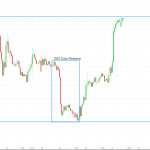Last week witnessed fluctuating movements in the EUR/USD pair, oscillating between 1.0725 and 1.0839. Despite the traditional quietude associated with Easter weeks, the unveiling of ISM data on Monday sparked a flurry of activity across the market.
This data underscored the resilience of the U.S. economy, instilling confidence among purchasing managers and painting a robust economic landscape. Conversely, German inflation rates continued their downward trajectory, aligning closely with market forecasts.
EURUSD 1HR

Amidst these developments, a tragic incident unfolded in the Gaza Strip, where seven aid workers fell victim to an inadvertent Israeli strike. This tragedy accentuated the persistent tensions in the region, highlighting the urgent need for de-escalation efforts championed by the United Nations.
In the short term, analysts foresee the EUR/USD maintaining a trading corridor between 1.0700 and 1.1000. While prospects of a permanent reduction in ECB’s key interest rates loom on the horizon, such measures are not anticipated at the forthcoming April meeting. Despite dwindling inflation rates, long-term interest rates continue to ascend, reflecting market trust in the forward guidance provided by central bankers.
Looking ahead, forthcoming data releases from the U.S., notably the Nonfarm Payrolls and Unemployment Rate data, are poised to offer further insights into the economic landscape. From a technical perspective, although the EUR/USD plumbed a new monthly nadir last week, current momentum seems to have temporarily abated, potentially paving the way for an upward reversal towards the 1.0830 mark.
In the medium term, central banks stand ready to address the declining inflationary pressures by contemplating interest rate cuts commencing in June. Both the Fed and the ECB may embark on a path of monetary accommodation to bolster economic recovery, although the exact timing and magnitude of these manoeuvres remain uncertain.
Furthermore, inflation dynamics on both sides of the Atlantic are evolving, with short-term deceleration anticipated to be followed by a resurgence in the long run. While global economic recovery efforts gain traction, risks such as inflationary upticks and geopolitical frictions persist.
Taking a longer-term perspective, while the euro may witness modest appreciation, significant gains appear elusive given prevailing economic dynamics and challenges such as burgeoning U.S. government debt. The resolution of geopolitical flashpoints, like the Ukraine conflict, holds promise for Europe’s economic prospects, while the impending U.S. presidential election in November 2024 could influence the trajectory of the greenback.
In conclusion, while recent economic indicators signal improvements, lingering uncertainties underscore the imperative for astute navigation and strategic decision-making in the ever-evolving financial milieu.
Disclaimer: The subject matter and the content of this article are solely the views of the author. FinanceFeeds does not bear any legal responsibility for the content of this article and they do not reflect the viewpoint of FinanceFeeds or its editorial staff.












